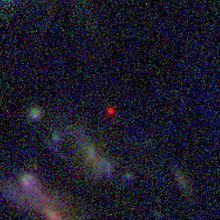| GLASS-z12 | |
|---|---|
 Close-up view of GLASS-z12 from the James Webb Space Telescope | |
| Observation data (J2000 epoch) | |
| Constellation | Sculptor |
| Right ascension | 00h 13m 59.76s[1] |
| Declination | −30° 19′ 29.1″[1] |
| Redshift | 12.117±0.012 (spectroscopic)[2] 12.4+0.1 −0.3[1] 12.42+0.27 −0.14[3] 12.28+0.08 −0.07[4] |
| Distance |
|
| Apparent magnitude (V) | 27.0 AB (F200W)[1] |
| Characteristics | |
| Mass | ≈1.0×109 M☉ |
| Size | ~3000 ly (1 kpc) |
| Half-light radius (physical) | 500 pc |
| Other designations | |
| GHZ2[6][7] · GLASS-17487[3] | |
References: [1] | |
GLASS-z12 (formerly known as GLASS-z13) is a Lyman-break galaxy discovered by the Grism Lens-Amplified Survey from Space (GLASS) observing program using the James Webb Space Telescope's NIRCam in July 2022.[8][9] Spectroscopic observations of GLASS-z12 by the Atacama Large Millimeter Array (ALMA) in August 2022 confirmed that the galaxy has a spectroscopic redshift of 12.117±0.012, making it one of the earliest and most distant galaxies ever discovered, dating back to just 350 million years after the Big Bang, 13.6 billion years ago.[10][5] ALMA observations detected an emission line associated with doubly ionized oxygen (O III) at 258.7 GHz with a significance of 5σ, suggesting that there is very low dust content in GLASS-z12, if not the early universe as well.[2] Also based on oxygen-related measurements, the age of the galaxy is confirmed.[11][12]
GLASS-z12 derives its name from the GLASS survey that discovered it and its estimated photometric redshift of approximately z = 12.4+0.1
−0.3.[1] GLASS-z12 was initially announced as GLASS-z13 because it was thought to have a higher redshift of z = 13.1.[7][2] This redshift value was later revised down to z = 12.4 in October 2022, resulting in the renaming of this galaxy.[1]
GLASS-z12 has a light-travel distance (lookback time) of 13.6 billion years.[5] However, due to the expansion of the universe, its present proper distance is 33.2 billion light-years.[5] It was discovered alongside another galaxy, GLASS-z10, comparable to GN-z11, also one of the oldest galaxies discovered.[10]

- ^ a b c d e f g Cite error: The named reference
Naidu2022was invoked but never defined (see the help page). - ^ a b c Cite error: The named reference
Bakx2022was invoked but never defined (see the help page). - ^ a b Cite error: The named reference
Donnan2022was invoked but never defined (see the help page). - ^ Cite error: The named reference
Harikane2022was invoked but never defined (see the help page). - ^ a b c d Cite error: The named reference
Wrightwas invoked but never defined (see the help page). - ^ Cite error: The named reference
Castellano2022was invoked but never defined (see the help page). - ^ a b Cite error: The named reference
TheAtlanticwas invoked but never defined (see the help page). - ^ O'Callaghan, Jonathan (20 July 2022). "JWST has found the oldest galaxy we have ever seen in the universe - Discoveries from the James Webb Space Telescope are pouring in, with an analysis of the latest data revealing a galaxy that dates back to just 300 million years after the big bang – the oldest we have ever seen". New Scientist. Retrieved 12 February 2023.
- ^ Cite error: The named reference
SA-20220914was invoked but never defined (see the help page). - ^ a b Cite error: The named reference
NASA2022was invoked but never defined (see the help page). - ^ Staff (25 January 2023). "Astronomers confirm age of most distant galaxy using oxygen". Phys.org. Retrieved 26 January 2023.
- ^ Bakx, Tom J.L.C.; et al. (23 December 2022). "Deep ALMA redshift search of a z ~ 12 GLASS-JWST galaxy candidate". Monthly Notices of the Royal Astronomical Society. 519 (4): 5076–5085. arXiv:2208.13642. doi:10.1093/mnras/stac3723. Retrieved 26 January 2023.